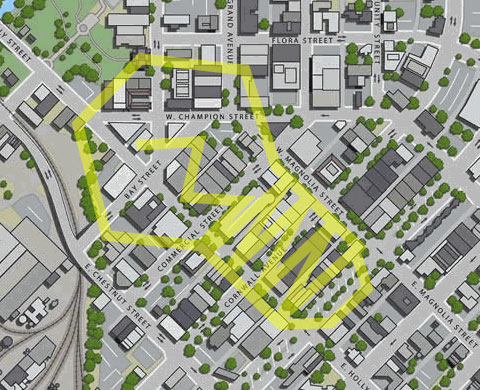Blinky Box Solution
How It Was Supposed To Work
Teams would work with (or against) each other to pull data out of the device, and discover the locations of the 22 letters in the maze. They would recognize that both the maze and address grid had the same 8x8 dimensions, and use this to assign 22 letters to 22 out of the 64 possible addresses. They would then use the walking map to find the locations of those addresses, mark them down, and keep track of the letters. Finally, they would draw on the map from location to location, connect-the-dots style, in the order presented by the letters. The resulting image would be well-formed and unambiguous, and the teams would immediately phone in the correct answer without any assistance from Game Control.
What Actually Happened
The device was installed in the museum's front window around 4:30 Saturday afternoon. A quick test between the installers and GC staff verified that it was working and responding to remote input. The museum closed soon after and the box waited for nightfall until the first visitors were scheduled to appear.
The first teams arrived late Saturday night, found the device, called the phone number, and queued up a bunch of commands. With no staff immediately on hand, it wasn't clear (to the teams) what was supposed to happen here, so players spent a decent amount of time collecting addresses and poking at the device over the phone before calling GC.
Something had happened in the 7 or so hours between installation of the device and the first team showing up, and it was no longer responding to input. None of the tubes were lighting up, and it was impossible for the teams to proceed. A check of the web service used to collect input showed that the computer driving the box was on and fetching data, so the problem was in the device itself or the software used to control it. In any case, teams needed an alternate mechanism to assign letters to addresses and complete the puzzle. We had the first five teams call in to GC to be given the data, while we scrambled to cook up such a mechanism.
Ultimately, we truncated the maze portion of the puzzle and simply modified the phone system to read out the letter/address matches. Teams then had to drive or walk the few blocks to locate these addresses on the map. The teams that jumped straight to this method solved the puzzle in fairly short order. Those that decided to use mapping software instead had much less fun. To get the picture to appear, building-level accuracy was required. Mapping software tends to be less accurate – addresses will often match to the nearest street or street corner, which screws up the final picture. The walking map included building and storefront outlines, which was supposed to be a hint – apparently a stronger up-front hint to get teams walking would have been helpful here.
Solution
Once teams plotted the locations on the provided map, they got the following image, which should be recognizeable as a LIGHTBULB (BULB was also an acceptable answer).

Design Notes
The museum was one of the first locations we found when brainstorming the initial route. When we visited, the neat collection of interesting equipment helped steer us into picking a steampunk/time travel theme. From the very first visit, our thoughts were, "how cool would it be to be able to plant something in this window?" We then turned to brainstorming what sort of thing we could build that would look at home in the museum, yet still provide an interesting puzzle. Several ideas along the lines of, "something using nixie tubes," or, "something shown on an oscilloscope," were thrown around, but little traction was made.
I was idly poking around online for inspiration, when I happened to do a web search for {steampunk lightbulb}, which dug up a page describing how to replace a lightbulb's guts with UV-reactive fluid. Using LEDs instead of higher-voltage devices seemed much more sane. The problem then was how to build a puzzle out of one or more of these glowing tubes.
The first iteration of the box followed the lightbulb recipe from the above site fairly closely. We ordered a batch of 50 tube-style lightbulbs, cored them out, plugged the ends with silicone putty, injected highlighter-saturated water, inserted LEDs, and sealed them up with epoxy. The process of dealing with glass shards, putty, epoxy, random crap growing in the not-quite-sterile water environment, leaking tubes, and a difficult (if not impossible) process for swapping out an individual tube, meant that any redesign would require a full rebuild.
The original idea for the box was to replicate the handheld game of Lights Out. In fact, the first incarnation of the box, which was inflicted on the beta participants back in April consisted of two iterations of that game, with a couple of rule changes thrown in between the two boards. None of the three teams solved this under two hours, and only one of the three seemed to enjoy it.
The rebuilt box used screw-top vials instead of lightbulbs. This made it possible to drill the holes, mount the caps, install the LEDs, and wire up the circuits without having to deal with any glass or liquid. The entire device could be tested first, and then the tubes could be filled and installed. It also means that the tubes can be removed and reused, so the box is likely to appear in some form or another (but hopefully working this time) in some future event.